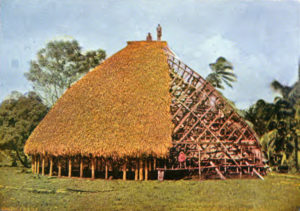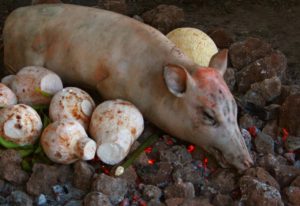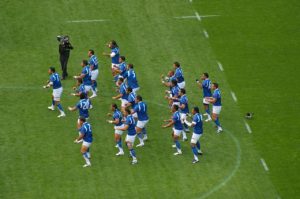[et_pb_section fb_built=”1″ _builder_version=”4.7.7″ _module_preset=”default” custom_margin=”-9px|-456px||-66px||” custom_padding=”2px||1px|||”][et_pb_row _builder_version=”4.7.7″ _module_preset=”default” custom_margin=”-23px|auto||auto||”][et_pb_column type=”4_4″ _builder_version=”4.7.7″ _module_preset=”default”][et_pb_text _builder_version=”4.7.7″ _module_preset=”default” text_font=”Poppins||||||||” custom_padding=”0px|||||” hover_enabled=”0″ sticky_enabled=”0″]
The Samoan way of life is deeply rooted in their traditional culture of Fa’a Samoa, which is characterized by communal living. Activities are usually carried out collectively, and the traditional houses called fale have no walls, allowing up to 20 people to sleep on the ground together in the same space. The fale serves as a place for socializing and unwinding during the day. Family is considered a fundamental aspect of a person’s life, with the extended family, known as aiga, living and working closely together. The elderly members of the family are held in high regard and enjoy the esteemed status, evident in traditional Sunday umu (oven) preparations.
Samoan culture is observed in both the Independent State of Samoa and American Samoa, which is a territory of the United States.
[/et_pb_text][et_pb_text _builder_version=”4.7.7″ _module_preset=”default” text_font=”Poppins||||||||” header_font=”Poppins||||||||” header_2_font=”Poppins||||||||” header_3_font=”Poppins||||||||” header_4_font=”Poppins||||||||” hover_enabled=”0″ sticky_enabled=”0″]
Traditional art forms
In Samoan culture, both men and women participate in the art of tattooing, known as tatau. Men’s tattoos are referred to as soga’i miki, while women’s tattoos are called malu.
Women also hold a significant role in the preservation of cultural practices by contributing their skills in creating important cultural items. For example, they are skilled in crafting ‘ie toga, intricately woven mats used in ceremonies and gift exchanges. In addition to ‘ie toga, women also create siapo, which is decorated bark cloth. During ritual exchanges, women typically give these fine mats and siapo, while men contribute woodworking items and red feathers as part of the exchange of material goods.

In Samoa, a barkcloth known as siapo, made from beaten mulberry bark, is a significant cultural element, similar to the Fijian tapa cloth called masi. Siapo is adorned with patterns or pictures painted with a natural brown dye sourced from trees. These designs often depict abstract or realistic representations of plant life, shells, fish, turtles, and hibiscus flowers. Siapo has multiple uses, including clothing, wrapping objects, and decorative purposes.
Traditional Samoan ornaments, jewellery, and hair accessories are crafted from natural materials like seashells, coconut, and coir. Traditional Samoan medicine, often used as a first-line treatment before hospital medicine, includes the use of plant leaves for massaging the affected area, as a form of alternative medicine.
In pre-Christian Samoa, wooden figurative sculpture was rare compared to Fijian and Tongan sculpture but shared some similarities with them.
‘Ava ceremony
The ‘ava ceremony is a significant ritual in Samoa that is performed before important occasions, including the bestowal of chiefly titles known as matai. The ceremony is highly ritualized, with specific gestures and phrases used at different times. Ceremonial items used in the ‘ava ceremony include the tanoa, a round wooden bowl similar to those used in kava cultures in other Polynesian societies. The tanoa comes in various sizes and is supported by short legs, often intricately decorated.
The ‘ava, also known as kava in other parts of Polynesia, is a beverage made from a plant that is consumed throughout the western Pacific region. In Samoa, the drinking of ‘ava is typically done through highly ritualized ‘ava ceremonies. The ‘ava is prepared by a group of people called aumaga and is served to participants by the tautua’ava, or ‘ava server, in a specific order determined by the tufa’ava, or ‘ava distributor. Generally, the highest-ranking chief of the visiting party is served first, followed by the highest-ranking chief of the host party, and then the service proceeds based on the rank of the remaining participants. The ‘ava is typically served in a polished coconut half-shell.
Dance
The traditional Samoan dance, known as siva, is characterized by gentle movements of the hands and feet in time to the music, typically performed by females. Another group dance called sasa is performed sitting to the rhythm of a drum. Males traditionally perform the fa’ataupati, a slap dance is done in a group without music accompaniment. Modern dance has also become popular among the younger generations in Samoa.
One unique aspect of Samoan culture is that traditional Samoan dance has largely remained untouched by Western civilization. The maulu’ulu is a group dance performed exclusively by females, and the taualuga is the main traditional dance performed by a village chief’s son (manaia) or village chief’s daughter (taupou). The taualuga is typically performed on special occasions such as weddings, birthdays, and other celebrations.
Before starting the taualuga, the performer, whether a manaia or taupou, bows their head and spreads their hands to thank the people for their support. The outfit for the taualuga is carefully prepared and includes fine woven mats symbolizing time, honour, and traditions, as well as red feathers from local birds. A Tapa, made from tree bark, represents the art and craft of Samoan culture. The Ula Nifo, a necklace made from whale tooth, is worn by the head chief or the person performing the taualuga, symbolizing wealth. In the 19th century, the taualuga was typically performed by a virgin who was the high chief’s son or daughter, adding to its cultural significance.
Languages
In both American Samoa and Samoa, it is common for people to be bilingual, speaking both English and Samoan. However, in Samoa, Samoan is more dominant and widely spoken, whereas, in American Samoa, English may be more commonly used. It’s worth noting that the inhabitants of Swains Island speak Tokelauan, a language specific to that particular island.
Names
Naming a child in the Samoan community holds significant meaning, with names carefully chosen to reflect various aspects of life:
Personal traits: Names like Malosi (meaning “strong”), Umi (meaning “tall”), Vave (meaning “fast”), or Faiaivale (meaning “foolish”) are chosen to convey specific personal traits or characteristics.
Religious: Names such as Toefuata’igaoletalalelei (meaning “restoration of the Gospel”) hold religious significance and reflect the importance of faith in Samoan culture.
Events: Names like Dodiana, created to commemorate the tragic deaths of Dodi Fayed and Princess Diana, showcase how important significant events can be in shaping Samoan names.
Objects: Names like Tala (meaning “dollar”) may be chosen to reflect the value or significance of money in Samoan culture.
Animals: Names like Maile (meaning “dog”) may be chosen to honour or depict animals that hold special significance in Samoan culture.
Descriptive: Names like Leilani (meaning “heavenly flower”) may be chosen to convey the beauty and grace associated with nature in Samoan culture.
Traditional: Names like Pua’a’elo, which was the name of a prominent Samoan high chief, may be chosen to honour and carry on traditional names within the community.
In Samoan culture, the meaning behind a given name is deeply valued, with names serving as a reflection of personal traits, beliefs, events, objects, animals, nature, and traditional heritage.
Dress
Samoan traditional attire for women is the exquisite puletasi, a stunning ensemble consisting of a matching skirt and tunic adorned with intricate Samoan designs. The puletasi is a true masterpiece of Samoan craftsmanship, reflecting the rich cultural heritage and artistic flair of the islands.
Meanwhile, the versatile lava-lava is a sarong that can be worn by both men and women. While lava-lavas come in various patterns and colours, men often opt for plain ones that may be worn as part of an official uniform. However, some men proudly display their individuality with lava-lavas featuring intricate and mesmerizing geometric patterns tattooed onto their lower bodies and upper legs. These tattoos, also known as pe’a, are a significant part of Samoan culture and are obtained through a traditional and highly painful process performed without any anaesthesia.
For special occasions and ceremonial events, Samoan attire is elevated with the inclusion of a majestic headdress called tuiga. Tuiga is meticulously crafted using shells and feathers, resulting in a headpiece that exudes regal elegance and symbolizes the wearer’s prestige and status within the community.
From the exquisite puletasi to the versatile lava-lava and the majestic tuiga, Samoan traditional attire is a true embodiment of the island’s rich cultural heritage and artistry, reflecting the pride and reverence the Samoan people have for their traditions and customs.
Cuisine

Sundays hold a special significance in Samoan culture, as they are traditionally observed as a day of rest and reflection. It’s a time when families come together to share a cherished tradition – the umu – a lavish Sunday afternoon meal that brings joy, warmth, and togetherness.
In a traditional Samoan household, the older members of the family take their seats and commence the meal, savouring the mouthwatering array of dishes that adorn the umu. The tantalizing aromas waft through the air, as the younger members and children eagerly await their turn to partake in the culinary feast.
The umu is a culinary masterpiece, boasting an abundance of delectable offerings that tantalize the taste buds. From succulent whole pigs, fresh seaweed, and crayfish to perfectly baked taro and rice, the umu presents a cornucopia of flavours and textures that delight the senses.
Coconut, a staple ingredient in Samoan cuisine, takes center stage in many dishes, adding a rich and luscious taste. One such dish is the renowned luau, where tender taro leaves are lovingly wrapped around a parcel of creamy coconut and baked to perfection in the umu. The dish is savoured in its entirety, including the leaves, and its coconut-infused goodness is a culinary delight that leaves taste buds craving for more.
The umu is not just a meal, but a cherished tradition that embodies the spirit of Samoan culture – the joy of family, the warmth of togetherness, and the delectable flavours of their beloved cuisine. It’s a time-honoured custom that brings generations together and creates cherished memories that last a lifetime.
Religion
Religion continues to play a significant role in the lives of the Samoan people today. Christianity remains the dominant faith in Samoa, with nearly 100% of the population identifying as Christians. The major Christian denominations in Samoa include the Congregational Christian, Roman Catholic, Methodist, The Church of Jesus Christ of Latter-day Saints, Assemblies of God, and Seventh-day Adventist. These denominations have a significant presence in the country, and churches often hold a central place in Samoan communities.
Sundays are considered a sacred day in Samoa, and many families attend church services, which are an integral part of the Samoan culture and tradition. Church buildings are often adorned with intricate decorations and are considered sacred spaces. Church choirs and hymn singing are highly valued in Samoan Christian worship, and music is an essential element of religious gatherings.
Apart from Christianity, there are also small populations of adherents of other religions in Samoa. For example, there are followers of the Bahá’í Faith, Islam, and Buddhism, among others. While these groups may be relatively small in numbers, they are respected and coexist peacefully with the Christian majority in Samoa.
Religious practices in Samoa are often intertwined with traditional customs and beliefs, reflecting the unique cultural heritage of the Samoan people. The Fa’a Samoa, which refers to the traditional Samoan way of life, is often closely connected with the practice of Christianity. Many Samoans view their Christian faith as being compatible with their traditional customs and values, and religious practices are often incorporated into traditional ceremonies and events.
There is a strong sense of community and fellowship within Samoan religious groups, with church members often supporting each other in various ways. Samoans also place a high value on giving back to their churches through financial contributions, volunteering, and participating in church-led community projects.
The Samoan government generally respects and protects the freedom of religion, as guaranteed by the country’s constitution. Religious diversity is acknowledged and celebrated in Samoa, and there have been no reports of societal abuses or discrimination based on religious belief or practice in recent years.
Overall, religion remains an integral part of the fabric of Samoan society, with Christianity being the dominant faith while also respecting and accommodating other religious beliefs. The fusion of Christianity with Samoan culture and customs creates a unique and vibrant religious landscape in Samoa today.
Sports
Sports continue to be a cherished part of Samoan culture, and the history of sports in Samoa has seen notable developments in recent years. Rugby union remains the most popular sport in Samoa, with the national team continuing to compete at a high level on the international stage. Samoa has participated in the Rugby World Cup in recent years, showcasing the country’s rugby talent to the world. The Samoa Rugby Football Union, along with other Pacific Island nations, has also been advocating for greater representation and support in global rugby competitions.

Rugby league has also gained popularity in Samoa, with the national team making strides in international competitions. Samoan players have been making their mark in professional rugby league competitions around the world, including the National Rugby League (NRL) in Australia and the Super League in the United Kingdom.
In addition to rugby, other sports have been gaining traction in Samoa. Soccer, also known as football, has seen increased participation, with the national team making efforts to improve its ranking and compete in regional and international competitions. Australian rules football, known as Samoa Rules, continues to be played and enjoyed in Samoa, with the national team participating in various international tournaments.
Furthermore, Samoans continue to have a strong presence in American professional wrestling. Wrestlers of Samoan heritage, such as Roman Reigns, Samoa Joe, and others, have gained popularity and success in the wrestling industry, showcasing the talent and resilience of Samoan athletes on a global platform.
Sports in Samoa are not only about competition and entertainment but also hold cultural significance. They promote community engagement, foster pride in Samoan identity, and provide opportunities for Samoan athletes to excel and represent their country on the world stage. As sports continue to evolve and grow in Samoa, they remain an integral part of the nation’s culture and history, showcasing the unwavering passion and talent of Samoan athletes.
Sports in American Samoa
Sports in American Samoa, as well as in the Independent State of Samoa, are a unique blend of cultural influences from both the United States and New Zealand/British influences. In American Samoa, American culture has had a significant impact, with American football, particularly the National Football League (NFL), being immensely popular. American football has become a significant part of the local culture, with many Samoans aspiring to play at the professional level in the NFL in the United States.
On the other hand, in the Independent State of Samoa, which has closer ties to New Zealand and Britain, rugby union has emerged as the most popular sport. Rugby union is deeply entrenched in Samoan culture, with a strong following among the local community. Soccer (football), netball, and volleyball are also popular sports in Samoa, reflecting the influence of New Zealand and British sporting traditions.
These sports not only provide avenues for physical activity and competition but also promote social cohesion, community engagement, and cultural preservation. Sports are an integral part of the fabric of Samoan society, with both traditional and modern sports being cherished and celebrated. They provide opportunities for Samoan athletes to showcase their talent, represent their community, and achieve success at national and international levels.
The unique blend of American and New Zealand/British influences has resulted in a diverse sports landscape in Samoa, with a wide range of sports being enjoyed and cherished by the local population. The passion and enthusiasm for sports in Samoa continue to grow, with Samoan athletes making their mark on the global stage and bringing pride to their homeland.
Fa’aaloaloga
The Fa’aaloaloga, a formal presentation of gifts, holds a significant place in Samoan culture during formal events such as weddings, chiefly installations (sa’ofaiga), funerals, and the opening of houses/churches. It is a time-honoured tradition that is deeply rooted in Samoan customs.
Since the formalisation of Christianity in Samoa, the process of Fa’aaloaloga has incorporated Christian elements, including the inclusion of Christian taeao or mornings in Samoan speeches. According to the set protocol, the first presentations are always offered to the religious representatives present at the event, followed by the highest-ranking chiefs in order of their rank.
A standard set of presentations, known as sua, typically includes vailolo, which is a drink with money in it and traditionally made with a coconut and a coconut frond called tuaniu. Additionally, it may consist of amoamosa, a tray of biscuits and material, or a combination of other small foodstuffs like a can of corned beef, and suatalisua, a box of corned beef and chicken or similar items. Following these, fine mats, also known as mats of state or o le malo, are presented. These mats can vary in size, ranging from 5 meters (16 ft) long to 25–30 meters (82–98 ft) long and 10 meters (33 ft) high.
Depending on the occasion and the rank of the person, the elements of the Fa’aaloaloga can be magnified several times by adding multiple items. It may also include a huge tapa cloth being tied to the young lady presenting the vailolo or draped several meters behind her as she presents it. The Fa’aaloaloga exemplifies the deep respect and reverence that Samoans hold for their culture, traditions, and social hierarchies, making it a cherished and integral part of Samoan formal events.
[/et_pb_text][/et_pb_column][/et_pb_row][/et_pb_section]


